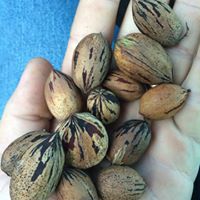
Several representative images come immediately to the mind and are definitive to the character of Texas. The Alamo, Longhorn cattle, and the oil industry, to name a few. One that is just as important, and should never be overlooked is the native pecan. Texas is a state that breeds real individual perspective, and has been a refuge for people and things to find and develop the best traits in themselves, and enables them to flourish regardless of who or what they are up against.
Nothing Naive About the Native Pecan
Native pecans fall into that category. They are harvested from trees that are as distinctive as the state they grow in, and they produce a nut that is just as unique in shape and flavor, setting them apart from the rest of the nut world.  Pecans have thrived in Texas for thousands of years. Spanish explorers on their arrival observed Native Americans gathering native pecans from the trees that seemed to be purposefully placed along the Texas Rivers.
Pecans have thrived in Texas for thousands of years. Spanish explorers on their arrival observed Native Americans gathering native pecans from the trees that seemed to be purposefully placed along the Texas Rivers.
Native pecans proliferated from their water sources and developed an original flavor that gave them a reputation of being a versatile and reliable nut. Slight flavor variations developed based on the land and waters sources that fed them. The trees themselves became well-known landmarks garnering monikers such as the "Mother Pecan Tree."
How Pecans are Native to North America
The wild population of trees prospered from the alkaline soil needed to create its fruit. The nitrogen and zinc affected the flavor of the meat as well as the hardness of the shell. The sizes differed from one thicket to the next, creating their reputation as a tasteful and wild specimen.
The popularity of the native pecan helped develop trade between the Native Americans and the Spanish explorers. The Spaniards traded the tree nuts in Europe as an appropriate snack for the upper classes, and as the Europeans settled the Americas, they profited from the Texas pecans by trading them to tribes and pioneers along the rivers and waterways that tied the continent together.
Popularity of Pecans Grows
From New Orleans heading north to St. Louis and Chicago, the native pecans from Texas found their place in the parlors and kitchens of every social class in the developing nation. Eventually moving east to the cities of Philadelphia, New York and Boston where the nut became subject to phonetic mispronunciation by the ‘Yankee’ population which pronounced it as ‘pee-can.’
The native pecan tree became one of nature’s first snack machines. The rich, velvety flavor was a favorite with everyone who tried them. As their popularity grew, so did the trade. Texas ranks consistently as one of the top suppliers for pecans. As they made their way east and west to European and Asian markets, consistency in shape, size, and flavor was needed to maintain the pecan presence in the marketplace.
Several varieties of different types of pecans were required to further the brand. Pecan producers needed to increase yield per tree and develop uniformity in shell size and shell thickness based on the users’ requirements.
Development of Many Difference Pecan Varieties
On experimental orchards many improved pecan varieties were raised and produced popular types such as Pawnee, Desirable, Cheyenne, Schley and San Saba. They contributed to a thriving market for both shelled and in-shell pecans, (a 4:1 ratio). These varieties were developed to meet the needs of those who chose to open the nut in their hand, for ease of brining and roasting, or for efficiently inserting them into machines for shelling. Each variation offers one characteristic or another to the buyer. Improved varieties also fought the weevil population and contributed to the needed increased yield.
The improved varieties led to growing trees at a height that would allow cattle to walk around them without hindering the harvest for ranchers who incorporated pecans orchards along with their cattle business. This uniformity enables patrons to offer consistent sweet treats throughout the year in the form of pecan pies, pecan candy, or in other taste useful forms.
Texas still grows native pecans along with the improved varieties. The ratio is close to 7:3, improved over native. The native pecan trees still enrich the visual landscape, they define the streams and rivers boundaries while supplying farmers and the local wildlife with a sturdy and viable food staple. Today the improved varieties develop in groves that number over 600,000 acres in Texas.
Adapting to methods needed to supply the growing world demands while keeping open a window to its past, native Texas pecan growers and distributors source the need for unique and tasty pecans that defined the ruggedness of early settlers while meeting the reputation and fulfilling the appetite of pecan aficionados in today’s world.

